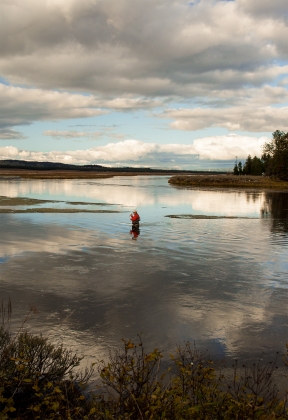
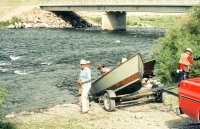
I received my first guide licenses in 1974 working for Jim Danskin in West Yellowstone. My license numbers were (and still are) Idaho #222, Montana #292. I was teaching so I had the summer months off but Sheralee and I still had some major fly tying contracts to fill. That was OK with Jim as he only needed somebody to handle overflow. He especially needed somebody who knew the Henry’ Fork. It turned out there was a lot of overflow so I ended up working some long hours guiding and tying flies.
I expected most if not all of my trips would be on the Henry’s Fork but my first trips were on the Madison during the salmonfly hatch. It was a harrowing experience because the only time I had ever been there was when dad took us to the slide area after the 1959 earthquake. The truth is, Jim had to draw me a map to even find the Madison. If not for my old friend Pat Barnes, I don’t know how I would have survived my first guide trip. However, once on the river, trout fishing was trout fishing and the fish were falling all over themselves for the big stoneflies. As I’ve always said to my own guides, when the fishing is great, anybody can guide. It’s when the fishing is tough that you find out what you’re made of.
That summer in West Yellowstone gave me a broadened perspective on some of the important fishing resources in our region. While most of my trips were on the Madison, we also took clients to the Gallatin, all of the great waters in Yellowstone Park, Hebgen Lake, Henry’s Lake, and even a few float trips on the Yellowstone River below Gardiner. After work I often fished the Madison, Firehole, Gibbon, Gallatin and smaller streams close to West Yellowstone.
This being the 40th anniversary of Henry’s Fork Anglers I have spent many hours reflecting on this rich legacy. In my past two blogs I have focused on the Henry’s Fork. In February I gave a historical perspective of our business. This time I want to talk about some of the other important waters in our area above and beyond the Henry’s Fork.
Madison River
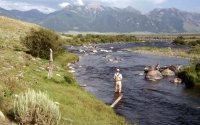
My first guiding year in 1974 coincided with Montana’s decision to stop stocking trout in the Madison River. The effect of that decision was immediate. The number of wild trout per mile increased dramatically once stocking was curtailed. By 1976 fishing was substantially better both in the number and size of trout than in 1974. Special wild trout regulations were in initiated in 1977 for the 30 mile section from Quake Lake downstream to Varney Bridge. This section was designated for catch and release with flies and artificial lures only.
By the mid-1980s the Madison River was the most productive trout stream in the State of Montana. Some estimates were more than 5000 trout per mile. The average size of the trout also increased significantly. It is possible that there were too many trout. While they appeared to be very healthy, the situation was set for disaster. The population, especially rainbows, took a significant nose dive starting in 1992 as a result of Whirling Disease. The free-fall continued through 1998 when the overall population was estimated at 1650 trout per mile, a decline of 70%.
The Montana Division of Fish, Wildlife & Parks resisted the demands from a portion of the fishing public to start stalking fish again. The only significant change in management was to close the section from Quake Lake to McAtee Bridge during the rainbow trout spawning season, from March 1 until the third Saturday in May. Each surviving generation of wild trout built an immunity to Whirling Disease until today, the population is back to what it was in the late 1980s. Today the Madison River is a significant part of our guiding program.
Yellowstone Park
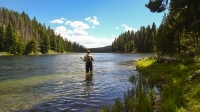
Most of the waters including the Madison, Firehole, Gibbon, Gallatin, Lamar River and Slough Creek haven’t changed much since we started our business 40 years ago. That alone is a great thing. It has always amazed me at the quality of fishing in the Park. The biggest change I have seen is the overall philosophy of managing these fisheries. In recent years the total focus has been on protecting native species. I agree with this 100%. What I don’t agree with is an all-out war on non-native species like rainbow and brown trout in waters where there is no evidence that native Yellowstone Cutthroat Trout ever existed in the past.
Today most of the park waters are included in a Native Trout Conservation Area. The Nonnative Tolerance area includes the Madison, Firehole, Lower Gibbon, Shoshone Lake, and Lewis Lake along with the small tributaries that feed these two lakes. It is unfortunate, in my opinion, that the Lewis River below Lewis Lake is not included. In the Native Trout Conservation Area there is no limit on nonnative species like brown trout. The Lewis River was once one of the finest brown trout streams in the region. This fishery has really declined since the new rules came into effect.
The Yellowstone River has seen the biggest change we’ve seen in the last 40 years. In the late 70s and 80s there were so many “cookie cutter” 17 inch cutthroats that the fishing was boring. Things quickly fell apart after the discovery of lake trout in Yellowstone Lake. The river fishery below the lake is almost totally dependent upon migratory fish. By 2010 the population hit an all-time low. An all-out effort to kill lake trout eventually bottomed things out. Today the fishery is on the rebound. You can check out my blog entitled Yellowstone on the Rebound for more detailed information.
Area Lakes
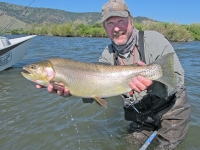
Island Park Reservoir, Henry’s and Hebgen Lake have always been important parts of our fishing operation. I think Island Park has seen the most changes in the past 40 years. I’ve discussed this a length in a previous blog but the fishing is definitely not what it used to be. This could be a combination of years of significant drawdowns along with a change in the genetic profile of the rainbow trout that have been stocked over the years. There was a day when you could drive out to one of the fingers on the west end, launch your float tube, and catch plenty of big rainbows. Not anymore. Today there is still some great fishing to be had but you’ll need a boat with a motor so you can get to some of the inlet springs and streams on the north side of the lake.
Henry’s Lake has had its ups and downs. While not plagued with water quantity issues, management in the early years was like throwing spaghetti against the wall to see what would stick. Over the years things changed for the better. Evaluating what the fishing is like to today depends on who you talk to. Some of the hard core anglers fish exclusively for the giant cuttbow hybrids that often reach double digit weights. Others want fast action and are happy with lots of 16” cutthroats. There are also brook trout that can reach over 20 inches. It’s hard to manage the fishery to please everybody but I think the IDF&G does a pretty good job meeting the expectations of most anglers.
Hebgen Lake has always offered excellent dry fly fishing for cruising browns and rainbows. I think this fishery has held up remarkably well over the years. These cruisers are called “gulpers” as a result of the way they feed on the surface. I’m old school when it comes to these fish and use a dry fly exclusively. Dropping a small nymph about a foot below your dry will definitely improve the odds.
South Fork of the Snake
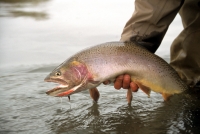
Until mom moved to Rigby after dad died in 1968 I had rarely fished this great river. First off, it isn’t an easy river to access if you don’t have a boat. There were several side channels that were convenient to access from the Heise River Road that I could wade. I also had an army surplus raft that I could float but I must admit, was a bit scary. It is a big dangerous river and you need to know what you’re doing when you float.
At any rate, I didn’t fish it enough in those days to make a good comparison with what it is like today. One thing I can say for sure is that the population of cutthroat was a much higher than rainbows and browns when compared to today. Once we established Henry’s Fork Anglers there was little reason to fish the South Fork because we didn’t have an outfitting permit for it. When I go fishing I like to know what’s going on in our legal operating area.
We were fortunate to acquire a business with a legal outfitting permit for the South Fork about 12 years ago. Since that time we’ve been busy. The greatest concern today is maintaining the genetic integrity of the native cutthroat trout population. While there is some great fishing for brown trout and rainbows, the South Fork is one of the last bastions for our native fish. The IDF&G has taken measures to control the rainbow population including removing the limit on rainbows, encouraging harvest of rainbows by tagging trout with a chip worth money when returned to the IDF&G, augmenting spring releases from Palisades Dam when possible to discourage rainbow spawning, and improving cutthroat spawning areas.
The South Fork is also a great compliment to the Henry’s Fork. While dry fly fishing isn’t very good in June when the Henry’s Fork is at its best, heavy hatches of large stoneflies, green drakes, PMDs, caddisflies and other aquatic insects produce some of the best dry fly fishing in the entire region during the peak of the summer.
Teton River
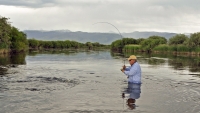
My personal history of this exceptional river goes back to my childhood in Sugar City. The Teton River forks away from itself into the North Fork and South Fork not far upstream. This water was easily accessible by bike when I was too young to drive. I spent most of my time working for farmers during the summer months. The Teton was close enough to fish a few hours after work.
The Lower Teton was changed forever when the Teton Dam collapsed on June 5, 1976. Check my blog earlier this summer for more details about this catastrophic event. I didn’t think I would ever see this precious resource fish again. Consequently, when offered an opportunity to purchase a business with a Teton permit, I turned it down.
Over the next 20 years or so I seldom thought about the Teton. There are only 4 legal outfitting permits on the river and eventually I started hearing some very good reports from anglers who fished the river with one of our competitors. My brother Rick and I checked it out a few times and we were pleasantly surprised at the quality of fishing. While the environs were changed forever, there were some huge cutthroat, rainbows and brown trout. Knowing this, it became very hard to own an outfitting business without a legal chance for our customers to fish this river that I once called home.
Three years ago an opportunity presented itself for us to acquire a permit to guide on the Teton. This required putting in a lot of time to relearn this great resource. Today there is no question that the number of trout per mile on the lower river is not close to what it was but the average size of the trout is much greater. Over the past 2 years the largest trout caught by our clients have been landed from the Lower Teton.
In my opinion the middle section which includes the whitewater canyon has changed little since I was a kid. I didn’t have a raft suitable to float this water but I frequently hiked down where there was a nice cutthroat behind every rock. It is still like that today. The upper river is basically a nice spring creek. Most of the larger trout are cutthroats with lots of smaller brook trout in the 6 – 12 inch range. The biggest change I notice today is there are more rainbows. So far these non-native fish have not had a significant impact on the native fishery. However, the IDF&G has removed limits from rainbows out of fear that they will hybridize with the native trout.
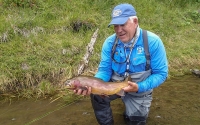
Overall I believe fishing today on almost all of the waters in our operating area is actually better than 40 years ago. Of course some of this is subjective. For example some feel fishing was better with more fish in the 17 inch range compared to fewer trout that are considerably larger. All in all, I think the focus on improving the resource with the advent of organizations like the Henry’s Fork Foundation, Madison River Foundation, Friends of the Teton River and more along with less focus on consumptive angling partly due to more progressive fishing regulations have definitely helped off-set some of the negative effects such as fires and drought.